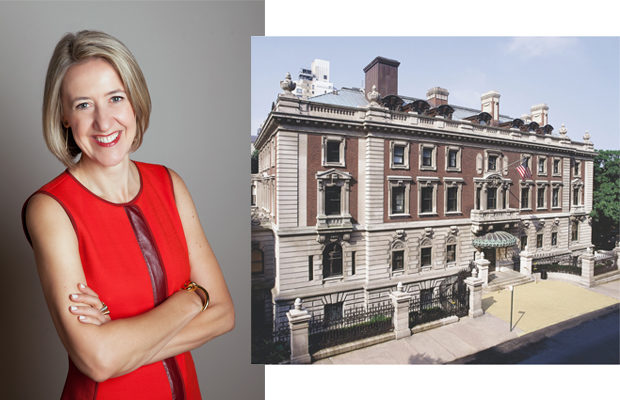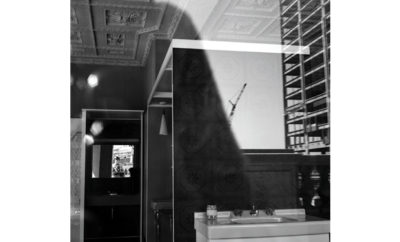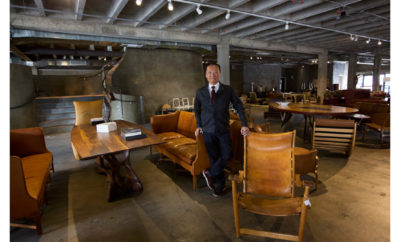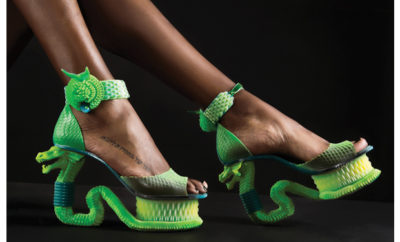 Caroline Baumann © ERIN BALANO | Cooper Hewitt, Smithsonian Design Museum. Matt Flynn photo.
Caroline Baumann © ERIN BALANO | Cooper Hewitt, Smithsonian Design Museum. Matt Flynn photo.
Feature
ENGAGING DESIGN
Caroline Baumann takes the helm at the newly expanded Cooper Hewitt,
Smithsonian Design Museum
SWISS-BORN, CAROLINE BAUMANN graduated from Bates College in Maine and has an MFA from New York University. Before coming to the Cooper Hewitt in 2001, where she has served in many capacities, including acting director on several occasions, she had been at the Museum of Modern Art from 1995. Following the death of Bill Moggridge, she was named director of Cooper Hewitt in June 2013.
As a collector and now as a trustee of the museum, I have gained enormous respect for Baumann’s intelligence, dedication, and enthusiasm—a perfect combination to lead the newly renamed Cooper Hewitt, Smithsonian Design Museum to the next level. For this wide-ranging interview for MODERN Magazine she took time from her hectic schedule to discuss the plans for the future and convey the excitement surrounding the reopening of the museum on December 12—the 112th anniversary of Andrew Carnegie moving into the Fifth Avenue mansion that has housed Cooper Hewitt since 1970.
You’re about to re-open the museum after a three-year renovation. What are we going to be surprised to see?
Everything! You’re in for a completely new Cooper Hewitt experience. Inside and out, every aspect of the museum has been renovated and reimagined. From a physical standpoint, our home in the historic Andrew Carnegie Mansion now has an incredible 60 percent more gallery space—16,000 square feet in which to showcase items from our permanent collection as well as temporary exhibitions. We’ve also completely reinvigorated the visitor experience by incorporating a number of interactive elements. Chief among these are a breakthrough Pen device, ultra–high-resolution digital tables, and dynamic spaces that encourage engagement.
The Pen is really key to the whole experience. All Cooper Hewitt visitors will be encouraged to take one as they enter the museum, and to collect and create with it as they move through the various spaces. One of the ways they can do this is by using the Pen in conjunction with the interactive tables; they’ll be located throughout the building and will allow visitors to play designer and explore the collection like never before. This will be particularly evident in the Immersion Room, an interactive space that will provide access to hundreds of our wallcoverings. Visitors can project them onto the walls for a truly immersive effect, or create their own designs and display them in the same fashion. And then there’s our Process Lab, another new, interactive space that encourages engagement by giving visitors the opportunity to experience the design process firsthand.

The innovative Cooper Hewitt Pen will allow visitors to collect and create designs as they move through the galleries.

Designed by Local Projects, the Immersion Room is an interactive space that provides access to the Cooper Hewitt’s hundreds of wallcoverings (or visitors can design their own), which can then be projected onto the walls for an immersive effect.
What do you like best about Diller Scofidio and Renfro’s renovation?
Such a hard question to answer…DS and R contributed a great deal to the renovation, and everything they’ve done has been nothing short of amazing. From the revitalized museum entrance on East Ninetieth Street—complete with illuminated piers on the corners of Fifth Avenue and Ninetieth and Ninety-First Streets—to the new first- and second-floor gallery layouts, to the exquisite cases they designed with the Cooper Hewitt team to showcase objects from the permanent collection, to a reinvigorated shop experience, they’ve really helped us execute our vision for a completely refreshed and reimagined museum experience.
What do you see as your role as the National Design Museum?
As part of our reinvention, we actually dropped the word “National” from our name, replacing it with “Smithsonian.” Many people don’t realize that Cooper Hewitt is part of the Smithsonian Institution’s network of nineteen museums and galleries, the largest such complex in the world. By emphasizing our connection with this venerable institution, we want to extend our reach, both nationally and internationally. In fact, one of our opening exhibitions, Tools: Extending Our Reach, actually features objects from ten Smithsonian museums.
The Smithsonian was established in 1846 “for the increase and diffusion of knowledge.” Today, we’re holding true to that vision, offering a stellar permanent collection and unique temporary exhibitions. And, with our new emphasis on access, people will have an opportunity to explore our offerings like never before, fulfilling Cooper Hewitt’s mission to educate, inspire, and empower people through design. Ultimately, that’s our role, nationally and internationally: it’s helping people to grasp the omnipresence of design and the impact it has on every aspect of our lives.

Tools: Extending Our Reach is the inaugural exhibition in the new 6,000 square feet of gallery space on the third floor.
What impact do you want your exhibitions to make? And what are your inaugural exhibitions?
We have a great lineup of inaugural exhibitions, starting with Designing the New Cooper Hewitt. The nine design firms that were instrumental in transforming Cooper Hewitt into a twenty-first-century design destination are featured, and each recounts its role, process, and the challenges it faced in executing its particular contribution(s).
On the first floor, Beautiful Users focuses on user-centered design. The exhibition is dedicated to the memory of Bill Moggridge, a pioneer of human- centered design who designed the first laptop computer (the GriD Compass, which is included in the exhibition), and who was the director of Cooper Hewitt from 2010 to 2012. Also on the first floor is Maira Kalman Selects, part of an ongoing series in which the museum invites guest curators to create installations drawn from the astonishing Cooper Hewitt collection. The exhibition features pieces from Kalman’s personal collection, as well as objects from Cooper Hewitt and other Smithsonian museums, to suggest the journey of a life story, from birth through death.

Maira Kalman’s gouache painting (2014) of Gerrit Rietveld’s Zig-Zag chair, and the chair, designed c. 1934.
The second-floor galleries will showcase gems from the permanent collection, and we’ll open with exhibitions that showcase important elements of design as well as the history of the collection: Making Design; The Hewitt Sisters Collect; Passion for the Exotic: Lockwood de Forest, Frederic Church; and an installation of exceptional eighteenth- and nineteenth- century models of staircases in the new Models and Prototypes Room. Finally, the third-floor now boasts 6,000 square feet of gallery space, and it will be inaugurated by the Tools exhibition I mentioned earlier. In terms of impact, we want our exhibitions to make visitors look at the familiar in unexpected ways, to learn something new or interact with something in a way they haven’t before. Our job is to provide the context and the experience, and let the design speak for itself. That’s what’s so exciting about the new Cooper Hewitt experience. We’re asking people to engage with our collection and exhibitions in a new way, actively participating rather than passively observing. We are confident that it will make for a much more gratifying and multidimensional visit and, we hope, a more memorable one as well.
How are you going to engage the community?
New York City has a vibrant design community. To really give you an idea of the scope, a study published this past May by the Center for an Urban Future noted that, as of 2013, New York was home to 40,340 full-time designers—that’s 65 percent more designers than any other metro region in the U.S. (and a 74 percent jump since 2000). What’s more, New York leads the nation in the number of design firms—3,884—encompassing fields such as fashion, graphic, interior, industrial, and landscape design as well as architecture.
The public here also has a great appetite for design, and there’s a demand and anticipation for what we’ll be offering: unprecedented interactive and immersive technologies paired with significantly expanded presentations of our rich collection and distinctive design exhibitions.
We’re committed to providing design education to our community at large and will continue to grow our stellar educational programming in that pursuit. Two years ago we opened the Cooper Hewitt Design Center in Harlem, and since then over thirty-five thousand students, families, and educators have walked through its doors. We also have a fantastic initiative called Design in the Classroom that has helped bring design awareness to over sixty thousand underserved New York City school children.
But our educational programs aren’t just for students. We’re inspiring and educating nearly two thousand adults through over thirty annual pro- grams, public lectures, conversations, and hands- on workshops that provide access to some of the greatest minds in the design field. What’s more,all of our public programs are streamed live and archived on our YouTube channel, making them widely accessible.
We have very solid relationships here in New York, and through our ongoing outreach efforts we will continue to engage the community. We’re also opening the Arthur Ross Terrace and Garden to the public, free of charge, in yet another gesture of accessibility; we want to invite the community to experience design in all its shapes and forms, and we want the community to feel welcome.
Not being from New York, I wonder how you are going to reach the public outside of New York.
We’re already reaching communities nationwide with our Design in the Classroom program. Having had such success with it right here at home, we expanded the program’s reach to classrooms in Washington D.C., New Orleans, San Antonio, Minneapolis, and Cleveland.
We’ve also taken our exhibitions around the globe during the renovation. For example, House Proud: Nineteenth-Century Watercolor Interiors from the Thaw Collection traveled to Paris, and then we forged new territory by sharing the exhibition at the Beijing World Art Museum in China. Showcasing our offerings worldwide is an important and exciting initiative, and we’re expanding it when our doors open.
And we’ve got a strong social media presence that reaches across the country and across the globe. You can find us on Facebook, Twitter, Instagram, and Pinterest, all of which encourage sharing information. That’s a key factor for us in continuing to expand our audience beyond New York. It also ties in with our focus on interactivity, as our new museum experience encourages visitors to actively participate and share their experiences.

Visitors will be able to create their own designs in the new Process Lab, one of the interactive innovations by Diller Scofidio and Renfro.
How big is your exhibition space?
Big! 16,000 square feet, spread over three floors, including our new 6,000-square-foot third-floor gallery. All this new space means that the seven newly renovated galleries on the second floor can now be used to display objects from our permanent collection, and we’re excited to finally share them with our public.
How big is the collection? What are its strengths and weaknesses?
Our permanent collection is expansive: more than 217,000 objects spanning thirty centuries. Started by the Hewitt sisters in 1897, it was intended as a working collection, one to be carefully studied, and whose objects would serve as a “visual library” to inspire students and designers alike.
One of the greatest strengths of the Cooper Hewitt collection is that it’s user-centered. The core collection was based on the principles of participation and outreach, which fit perfectly with our redefined goals for an interactive museum experience, and we’ve continued to build on this foundation in our subsequent collecting efforts.
The collection is also tremendously rich and diverse, but what makes it unique is the range of design processes and manufacturing techniques that it exhibits across our four curatorial departments. Our focus now is on continuing to build our twentieth- and twenty-first-century collections, and providing new ways to display and discuss our evolving collection in keeping with our desire to promote greater accessibility.
Here are just a few examples of the exquisite objects that will be on view when we open: a glass vase designed by Gaetano Pesce while he worked at the French glass center, CIRVA; a 3-D printed urn designed by Michael Eden [pro- filed on p. 102]; and a late nineteenth- or early twentieth-century birdcage from Italy, modeled after the Rialto Bridge, that was donated by the Hewitt sisters.
We’re also working on expanding our collection through the addition of born-digital design objects. To that end, we recently acquired Planetary, an iPad music application. It’s an important example of interaction design and interactive data visualization and, by acquiring its source code, we’re also able to reveal the underlying design decisions made through its creation and evolution. The acquisition highlights our own evolution, and is something we will continue to build on.
The Cooper Hewitt store will be much expanded. Can you tell us more about it?
Yes, our shop will be completely redesigned and we’ll have a greater range of merchandise than ever before. From the historic to the contemporary, our shop offerings will be more reflective of Cooper Hewitt’s de- sign philosophy, mission, and collection. There’s also going to be more emphasis on products related to our exhibitions, programs, and permanent collection. Plus the shop will serve as a specialist destination for design and architecture publications. We’ll also continue to carry our exclusive “Museum Souvenir” items—souvenirs commissioned by contemporary artists and designers. With such a wide variety of high design offerings, the shop will be a great complement to the visitor experience, as well as a destination for design-savvy customers. All of this is also available in our online shop at shop.cooperhewitt.org, which has remained open during the renovation.












